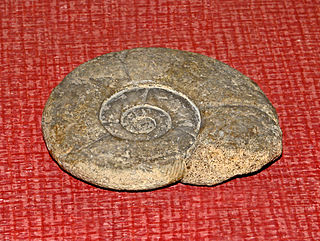
Mariella is an ammonoid genus, named by Nowak (1916) from the upper Albian and Cenomanian stages of the mid Cretaceous, included in the Turrilitidae. Its type is Turrilites bergeri

Scaphites is a genus of heteromorph ammonites belonging to the Scaphitidae family. They were a widespread genus that thrived during the Late Cretaceous period.

Euhoplites is an extinct ammonoid cephalopod from the Lower Cretaceous, characterized by strongly ribbed, more or less evolute, compressed to inflated shells with flat or concave ribs, typically with a deep narrow groove running down the middle. In some, ribs seem to zigzag between umbilical tubercles and parallel ventrolateral clavi. In others the ribs are flexuous and curve forward from the umbilical shoulder and lap onto either side of the venter.

Australiceras is an extinct ammonite genus from the upper part of the Early Cretaceous, Aptian stage, included in the family Ancyloceratidae.
Anasirenites is a genus of extinct ammonoid cephalopods within the family Trachyceratidae which is part of the ceratitid superfamily Clydonitaceae; sometimes considered a subgenus of Sirenites. Anasirenites is characterized by a ventral furrow bordered on either side by a continuous keel. The shell, as for Sirenites, is compressed with whorls flattened-convex on the sides. Sigmoidal ribs on the flanks bifurcate near the ventro-lateral shoulder on tubercles and project sharply adorally. Whorl sides are tuberculate with tubercles arranged in spiral lines. The suture is ammonitic. Anasirenites, first described by Mojsisovics in 1893 is known from the Upper Triassic of the Alps, Sicily, and the Himalaya.
Beudanticeras is an extinct cephalopod genus from the Late Cretaceous period; Albian and Cenomanian, belonging to the ammonoid subclass and included in the family Desmoceratidae.

Pachydiscus is an extinct genus of ammonite from the Late Cretaceous and Early Paleocene with a worldwide distribution, and type for the desmoceratacean family Pachydiscidae. The genus' type species is P. neubergicus. Altogether some 28 species have been described.

Hoploscaphites is an extinct ammonite genus from the Upper Cretaceous and the Lower Paleocene, included in the family Scaphitidae.

Collignociceras is a strongly ribbed and tuberculate, evolute ammonite from the Turonian of the western U.S. and Europe belonging to the ammonitid family Collignoniceratidae. The genus is named after the French paleontologist Maurice Collignon. The type is Collignoniceras woollgari, named by Mantell in 1822 for specimens from Sussex, England.

Mammites is a Late Cretaceous ammonite genus included in the acanthoceratoidean family, Acanthoceratidae, and the type genus for the subfamily Mammitinae. Mammites was named by Laube and Bruder in 1887.

Forresteria is an extinct genus of cephalopod belonging to the subclass Ammonoidea. They flourished during the late Turonian and early Santonian of the Late Cretaceous, and were global in extent. Forresteria alluaudi and Forresteria hobsoni are considered marker fossils for the lower Coniacian in the American West.
Shloenbachiidae is a family of hoplitoid ammonoid cephalopds mostly from the lower Upper Cretaceous,.
Brancoceratidae is a family of acanthoceratoid ammonites from the middle of the Cretaceous, recognized by their commonly evolute shells with round, oval, or quadrate whorls, strong ribs, usual ventral keels, and at least, umblical tubercles. The family is thought to be derived from the Desmoceratidae (Desmoceratoidea), perhaps from Silesitoides or some allied genus.

Hypophylloceras is a Cretaceous ammonite with a finely ribbed, compressed, involute shell; some having periodic stronger ribs or folds. The suture is complex, with large, asymmetric and finely divided lobes; the 1st lateral being much larger than the external (=ventral) and 2nd lateral lobes. Saddle endings commonly not phylloid.

Calycoceras is an extinct genus of cephalopods belonging to the subclass Ammonoidea and family Acanthoceratidae that lived during the Cenomanian stage of the Late Cretaceous, 100-94 Mya. Their shells had ornate ribs.

Mantelliceras is an extinct ammonoid cephalopod genus belonging to the family Acanthoceratidae and type for the subfamily Mantelliceratinae, that lived from the Late Albian to the late Cenomanian stage of the Late Cretaceous.

Puzosia is a genus of desmoceratid ammonites, and the type genus for the Puzosiinae, which lived during the middle part of the Cretaceous, from early Aptian to Maastrichtian. Sepkoski defines the range from Albian to Santonian. The generic name comes from the Serbian words "Puž" (snail) and "oce/ose" (axis), gaining its name from the shell's snail-like appearance.

Meekoceras is an extinct genus of ceratitid ammonites with a discoidal shell that lived during the Early Triassic Epoch.
Flickiidae is a family of dwarf ammonites with little ornament and very simples sutures known from small pyritic specimens found in middle Cretaceous deposits. Inclusion in the Acanthoceratoidea is tentative.
Ursquilla is an extinct genus of mantis shrimp that lived in Israel and Jordan during the Campanian stage of the Late Cretaceous period. It contains a single species, Ursquilla yehoachi.














